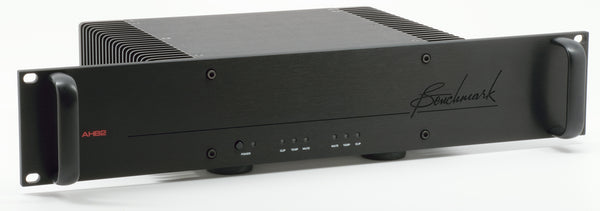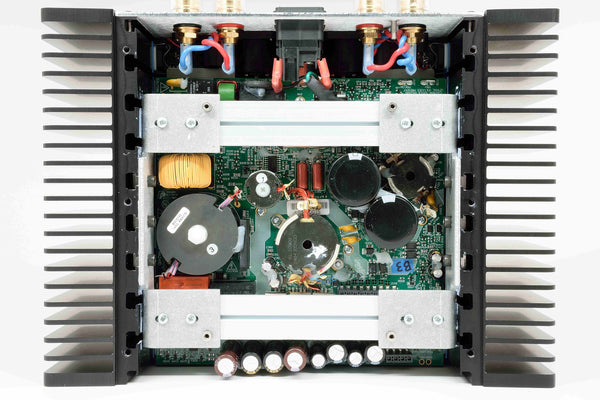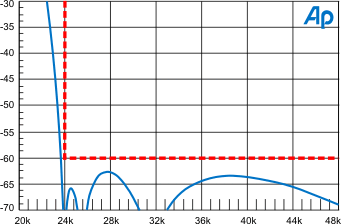Buy one component and save 10% on up to 2 cables. Buy 2 components and get 4 free cables. Free shipping on USA orders over $700.
Buy one component and save 10% on up to 2 cables. Buy 2 components and get 4 free cables. Free shipping on USA orders over $700.
Laboratory Use of the Benchmark AHB2 Power Amplifier
by John Siau January 26, 2018

SEAS driver test system uses Benchmark AHB2
SEAS, a well-known manufacturer of high-quality loudspeakers, selected the Benchmark AHB2 as a key component for use in testing loudspeakers. They created an innovative test system that measures loudspeaker motor strength and moving mass with higher accuracy than previous methods. This new measurement system was documented in the December 2017 Journal of the Audio Engineering Society (link in references).
According to the AES paper, the SEAS team selected the Benchmark AHB2 for the following reasons:
"A Benchmark AHB2 amplifier is used, which has excellent signal-to-noise ratio and bandwidth, low output impedance, and is suitable for laboratory use (with advanced overload protection)."
"Is the AHB2 suitable for laboratory use?"
In late 2016, SEAS contacted Benchmark about the possibility of using the AHB2 power amplifier in a laboratory environment. They needed an amplifier with exceptionally wide bandwidth, low noise, low output impedance, low distortion, and bulletproof overload protection.
The AHB2 offers a solution that is more than 15 dB quieter than other top-quality high-end amplifiers. Distortion is virtually non-existent, even when heavily loaded with low impedances. The -3 dB bandwidth extends from 0.1 Hz to 200 kHz with an exceptionally flat response. The extended bandwidth provides the precise phase response that their application requires. Last but not least, the FPGA-based protection system in the AHB2 provides the robust protection necessary in a laboratory environment.
One independent test lab had this to say about the AHB2:
"I measured less distortion and noise in the AHB2 than in any other of the many power amps I've measured over the years.”
-Bascom King, BHK Labs

AHB2 Overload Protection System
The protection system monitors:
- Output voltage
- Output current
- Output power
- Output distortion
- Output clip
- Safe operating region
- Power supply transistor temperatures
- Power supply transformer temperatures
- Output transistor temperatures
- Short circuit detection
- DC fault detection
- AC fault detection
- 12V trigger input
- Mono/Stereo switch position
- Gain switch position
The protection system controls the following:
- Audio enable/mute sequencing
- Input gain relay sequencing
- Mono/stereo relay sequencing
- Power supply enable
- 12V Trigger output
- Error display lamps
Key performance parameters of the AHB2
- Less than 0.0003 % THD at full rated power, 20 Hz to 20 kHz
- 100 watts/channel into 8 Ohms
- 380 watts mono into 8 Ohms
- 132 dB A-weighted SNR, Stereo Mode
- 135 dB A-weighted SNR, Mono Mode
- A-weighted output noise: -103 dBV, -101 dBu, 7.1 uVrms, Stereo Mode
- A-weighted output noise: -100 dBV, -98 dBu, 9.8 uVrms, Mono Mode
- THD at 1 kHz, full rated power, stereo mode: < 0.00011%, 20 kHz LPF
- THD at 1 kHz, full rated power, mono mode: < 0.00010%, 20 kHz LPF
- Frequency response 0.1 Hz to 200 kHz +0/-3 dB
- Maximum peak output current: 29 A, both channels driven
- Very low magnetic emissions, may be stacked with other equipment
- Very low out-of-band noise (the AHB2 is not a class-D amplifier)
- No relays in output path
- No relays in high-current paths

Unique features of the Benchmark AHB2
- Linear class-AB amplifier with parallel class-A feed-forward amplifier
- Patented THX AAA low-distortion topology.
- Class-H tracking rails extend output power and voltage while maintaining high efficiency
- Tightly regulated power supplies provide constant voltage to output stages under all load conditions. This provides predictable peak power and voltage at the outputs.
- Switching power supply operating well above the audio band (above 500 kHz). The high frequency operation eliminates large line-frequency transformers that emit large magnetic fields. The high frequency design allows internal filtering that does not interfere with the audio bandwidth. The exceptionally low magnetic emissions allow a compact package without compromising the noise performance.
- Advanced protection system with real-time monitoring of all system parameters including output distortion. If the amplifier is over driven, the protection system mutes the output before tweeter damage can occur.
The AHB2 is not a Class-D Amplifier
The audio path in the AHB2 is an entirely linear design. It uses a parallel structure that includes a class-AB amplifier and a class-A feed-forward correction amplifier. The class-AB amplifier operates inside of class-H tracking rails that are also fully linear. The tracking rails provide efficiency that approaches that of a class-D amplifier while entirely avoiding the noise and distortion produced by class-D designs.
The important difference between the AHB2 and class-D amplifiers is that the AHB2 does not produce switching noise. Class-D amplifiers are measured with brick-wall AES17 filters that ignore the switching noise above 20 kHz or 40 kHz. Tweeters can demodulate this ultrasonic noise and fold it into the audible band.
Class-D amplifier switching noise can create problems in a loudspeaker measurement system. More importantly, this ultrasonic noise may become audible when it is demodulated by the non-linearities that occur in all loudspeakers. This potential source of distortion may detract from our musical enjoyment. Class-D amplifiers are compact and cheap, but are not necessarily a good choice for a high-end Hi-Fi system.
 Class-D amplifiers are not as clean as some specifications seem to imply. It is important to understand that AES17 distortion and SNR measurements use a brick-wall filter (shown at left) to ignore the noise produced by class-D amplifiers. This noise may make class-D amplifiers unsuitable for some measurement systems.
Class-D amplifiers are not as clean as some specifications seem to imply. It is important to understand that AES17 distortion and SNR measurements use a brick-wall filter (shown at left) to ignore the noise produced by class-D amplifiers. This noise may make class-D amplifiers unsuitable for some measurement systems.
Summary
The AHB2 was designed to outperform all competing power amplifiers in terms of noise and distortion. It achieves these design goals and sets benchmarks in these key performance parameters. The result is an amplifier with unrivaled transparency.
Our goal was to create the ultimate amplifier for the enjoyment of music. It is nice to know that the AHB2 is also being used to test new and improved loudspeakers!
References
"An Added-Mass Measurement Technique for Transducer Parameter Estimation", Jeff Candy and Claus Futtrup, Journal of the Audio Engineering Society Vol. 65, No. 12, December 2017 (C 2017) DOI: https://doi.org/10.17743/jaes.2017.0040
"The AHB2 - A Radical Approach to Audio Power Amplification", John Siau, Benchmark Application Notes: https://benchmarkmedia.com/blogs/application_notes/14680625-the-ahb2-a-radical-approach-to-audio-power-amplification
"Optional Filters S-AES17 Low Pass Filter", Audio Precision: http://www.audiotech.com.tw/AES17%20Filter.htm
Related Application Notes
Also in Audio Application Notes

How Loud is the Distortion from Your Power Amplifier?
by John Siau August 08, 2025
Would you put a Washing Machine in your Listening Room?
If the answer is no, you may be surprised to discover that the distortion produced by your power amplifier may be louder than the noise produced by a major appliance.
Don't believe me? Take a look at Stereophile's test reports:
We selected 7 power amplifiers from Stereophile's top list of recommended amplifiers.
We took Stereophile's "THD+N vs. Power" plots for each, and replotted the data in a format that shows the loudness of the THD+N at the listening position.
The results are shocking!
Amplifier THD+N is louder than expected!
The distortion from your amplifier may be louder than a washing machine on the spin cycle, or it may be totally silent. How does yours perform? The answer is hidden in Stereophile's THD+N plots.
This application note reveals the hidden truth:
"The Distortion from your Power Amplifier may be Louder than a Washing Machine!"
I know, it sounds crazy, but this is what the measurements show!

Interpolator Overload Distortion
by John Siau November 20, 2024
Most digital playback devices include digital interpolators. These interpolators increase the sample rate of the incoming audio to improve the performance of the playback system. Interpolators are essential in oversampled sigma-delta D/A converters, and in sample rate converters. In general, interpolators have vastly improved the performance of audio D/A converters by eliminating the need for analog brick wall filters. Nevertheless, digital interpolators have brick wall digital filters that can produce unique distortion signatures when they are overloaded.
10% Distortion
An interpolator that performs wonderfully when tested with standard test tones, may overload severely when playing the inter-sample musical peaks that are captured on a typical CD. In our tests, we observed THD+N levels exceeding 10% while interpolator overloads were occurring. The highest levels were produced by devices that included ASRC sample rate converters.

Audiophile Snake Oil
by John Siau April 05, 2024
The Audiophile Wild West
Audiophiles live in the wild west. $495 will buy an "audiophile fuse" to replace the $1 generic fuse that came in your audio amplifier. $10,000 will buy a set of "audiophile speaker cables" to replace the $20 wires you purchased at the local hardware store. We are told that these $10,000 cables can be improved if we add a set of $300 "cable elevators" to dampen vibrations. You didn't even know that you needed elevators! And let's not forget to budget at least $200 for each of the "isolation platforms" we will need under our electronic components. Furthermore, it seems that any so-called "audiophile power cord" that costs less than $100, does not belong in a high-end system. And, if cost is no object, there are premium versions of each that can be purchased by the most discerning customers. A top-of-the line power cord could run $5000. One magazine claims that "the majority of listeners were able to hear the difference between a $5 power cable and a $5,000 power cord". Can you hear the difference? If not, are you really an audiophile?

